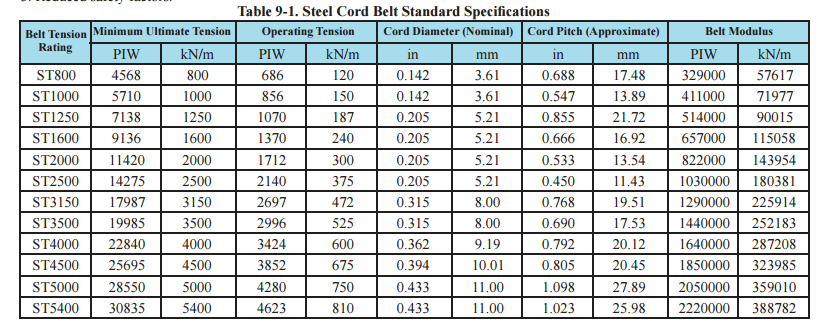CONVEYOR BELT AND SYSTEM TENSION CALCULATIONS
Conveyor systems will take on a variety of configurations relative to drive location, elevation or descent of the load, idler and pulley type and condition, and other factors too numerous to detail in this handbook. belt manufacturers or conveyor engineering companies should be consulted for belt (system) recommendations. The tables below provide an example of the basic information on steel cord reinforced belt tension ratings. Information on a specific belt construction can be provided by the belt manufacturer.
42″ ST1000 1/4″ X 7/16″ Steel cord belt
The data in the following tables apply if the following service conditions are met: Vulcanized Splice
1. Pulley diameters recommended by the belt manufacturer are used.
2. Automatic take-up with adequate take-up travel.
3. Splices are made strictly in accordance with the belt manufacturer’s specifi cations. Where an adverse environmental condition or some special belt application exists, it is critical that the belt tension rating be reviewed with the belt manufacturer.
Some of the special conditions are:
1. Continuous excessive ambient temperature.
2. Exposure to deleterious chemicals.
3. Reduced safety factors.
ELONGATION
Most new conveyor belts will exhibit permanent stretch very early in their service life, as a result of the normal cyclic tensile forces exerted by the conveyor system on the belt. This length change will vary among belt constructions, but it is generally much less than one percent of the original relaxed length of the belt.
The conveyor take-up system must compensate for this length change as well as the normal belt elongations which are proportional to belt tensions in the elastic region of the stress strain curve. The initial take-up position is that which the take-up finds after the clamps have been removed and the belt run empty a few belt revolutions to produce a natural tension distribution.

